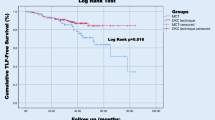Abstract
Purpose of Review
Recent advances in endovascular techniques and device technology have led to increased utilization of endovascular treatment for patients with severe aortoiliac occlusive disease. In this review article, we will discuss various clinical and technical considerations in endovascular treatment of patients with TASC C and D aortoiliac lesions and provide review of the existing literature.
Recent Findings
While primary patency remains superior following open aortoiliac reconstruction, secondary patency, limb salvage and survival following endovascular management of aortoiliac occlusive disease rival those for open surgical management. In addition, endovascular management offers lower perioperative morbidity and mortality and shorter hospital stay and does not preclude patients from undergoing aortobifemoral bypass in the future should the initial endovascular treatment fail. Covered stent grafts result in improved patency for TASC C and D common iliac artery lesions and concomitant common femoral endarterectomy can be performed with good result in those with disease extending into the common femoral artery.
Summary
With careful patient selection and operative planning, endovascular intervention for TASC C and D aortoiliac lesions can be performed with excellent results and should be considered as the first line treatment in patients with severe AIOD.
Similar content being viewed by others
References
Papers of particular interest, published recently, have been highlighted as: “•” Of importance "••" Of major importance
Brewster DC, Darling RC. Optimal methods of aortoiliac reconstruction. Surgery. 1978;84:739–48.
•De Vries SO, Hunink MG. Results of aortic bifurcation grafts for aortoiliac occlusive disease: a meta-analysis. J Vasc Surg. 1997;26:558–69. A large meta-analysis of open aortic repair outcomes for aortoiliac occlusive disease.
Hertzer NR, Bena JF, Karafa MT. A personal experience with direct reconstruction and extra-anatomic bypass for aortoiliofemoral occlusive disease. J Vasc Surg. 2007;45:527–35.
•Jongkind V, Akkersdijk GJ, Yeung KK, Wisselink W. A systematic review of endovascular treatment of extensive aortoiliac occlusive disease. J Vasc Surg. 2010;52:1376–83. Review of cohort studies on endovascular management of aortoiliac occlusive disease.
Leville CD, Kashyap VS, Clair DG, Bena JF, Lyden SP, Greenberg RK, et al. Endovascular management of iliac artery occlusions: extending treatment to TransAtlantic Inter-Society Consensus class C and D patients. J Vasc Surg. 2006;43:32–9.
Whiteley MS, Ray-Chaudhuri SB, Galland RB. Changing patterns in aortoiliac reconstruction: a 7-year audit. Br J Surg. 1996;83:1367–9.
Upchurch GR, Dimick JB, Wainess RM, Eliason JL, Henke PK, Conwan JA, et al. Diffusion of new technology in health care: the case of aorto-iliac occlusive disease. Surgery. 2004;136:812–8.
Norgren L, Hiatt WR, Dormandy JA, Nehler MR, Harris KA, Fowkes FG, et al. Inter-Society Consensus for the Management of Peripheral Arterial Disease (TASC II). Eur J Vasc Endovasc Surg. 2007;33(suppl 1):S1-75.
Reed AB, Conte MS, Donaldson MC, Mannick JA, Wittemore AD, Belkin M. The impact of patient age and aortic size on the results of aortobifemoral bypass grafting. J Vasc Surg. 2003;37:1219–25.
AbuRahma AF, Hayes JD, Flaherty SK, Peery W. Primary iliac stenting versus transluminal angioplasty with selective stenting. J Vasc Surg. 2007;46:965–70.
Goode SD, Cleveland TJ, Gaines PA. Randomized clinical trial of stents versus angioplasty for the treatment of iliac artery occlusions (STAG trial). Br J Surg. 2013;100:1148–53.
Tetteroo E, van der Graaf Y, Bosch JL, van Engelen AD, Hunink MG, Eikelboom BC, et al. Randomized comparison of primary stent placement versus primary angioplasty followed by selective stent placement in patients with iliac-artery occlusive disease. Dutch Iliac Stent Trial Study Group. Lancet. 1998;351:1153–9.
•Kashyap VS, Pavkov ML, Bena JF, Sarac TP, O’Hara PJ, Lyden SP, et al. The management of severe aortoiliac occlusive disease: endovascular therapy rivals open reconstruction. J Vasc Surg. 2008;48:1451–57. A large single center comparison of open versus endovascular management of severe aortoiliac occlusive disease.
Chang RW, Goodney PP, Baek JH, Nolan BW, Rzucidlo EM, Powell RJ. Long-term results of combined common femoral endarterectomy and iliac stenting/stent grafting for occlusive disease. J Vasc Surg. 2008;48:362–7.
••Mwipatayi BP, Thomas S, Wong J, Temple SEL, Vijayan V, Jackson M, et al. A comparison of covered vs bare expandable stents for the treatment of aortoiliac occlusive disease. J Vasc Surg. 2011;54:1561–70. A randomized controlled trial comparing covered versus bare-metal balloon-expandable stents in treatment of severe aortoiliac occlusive disease.
••Mwipatayi BP, Sharma S, Daneshmand A, Thomas SD, Vijayan V, Altaf N, et al. Durability of the balloon-expandable covered versus bare-metal stents in the Covered versus Balloon Expandable Stent Trial (COBEST) for the treatment of aortoiliac occlusive disease. J Vasc Surg 2016;64:83–94. Long term outcomes of the COBEST.
Grimme FA, Goverde PC, Verbruggen PJ, Zeebregts CJ, Reijnen MM. First results of the covered endovascular reconstruction of the aortic bifurcation (CERAB) technique for aortoiliac occlusive disease. Eur J Vasc Endovasc Surg. 2015;50:638–47.
Rzucidlo EM, Powell RJ, Zwolak RM, Fillinger MF, Walsh DB, Schermerhorn ML, et al. Early results of stent-grafting to treat diffuse aortoiliac occlusive disease. J Vasc Surg. 2003;37:1175–80.
Funding
No funding was received.
Author information
Authors and Affiliations
Corresponding author
Ethics declarations
Conflict of interest
The authors declare no conflicts of interests with respect to authorship or publication of this manuscript.
Research Involving Human and Animal Rights
This article does not contain any studies with human or animal subjects performed by any of the authors.
Additional information
Publisher's Note
Springer Nature remains neutral with regard to jurisdictional claims in published maps and institutional affiliations.
Rights and permissions
Springer Nature or its licensor (e.g. a society or other partner) holds exclusive rights to this article under a publishing agreement with the author(s) or other rightsholder(s); author self-archiving of the accepted manuscript version of this article is solely governed by the terms of such publishing agreement and applicable law.
About this article
Cite this article
Kang, J., Kim, A.H. & Zhang, J.M. Endovascular Management of TASC-C and D Aortoiliac Occlusive Disease. Curr Surg Rep 11, 17–22 (2023). https://doi.org/10.1007/s40137-022-00341-w
Accepted:
Published:
Issue Date:
DOI: https://doi.org/10.1007/s40137-022-00341-w




